
The nightstand is like the shoe of bedroom furniture. Not only does it serve an important purpose, but it can also be a powerful expression of your personal style.
Like shoes, nightstands come in so many different types, styles, materials and colors, your choices are practically infinite. Unlike shoes, you can have just one nightstand if you like. And, according to interior design experts, if you do have two, they need not match!
Related: Types of Bedside Lamp | Small Bedside Table | Unique Nightstands | Nightstand Alternatives
A. Main Types
Functionally speaking, there have long been three basic types of nightstands: chests, cabinets and tables. There is now a fourth type: the “smart” nightstand.
1. Bedside Chests
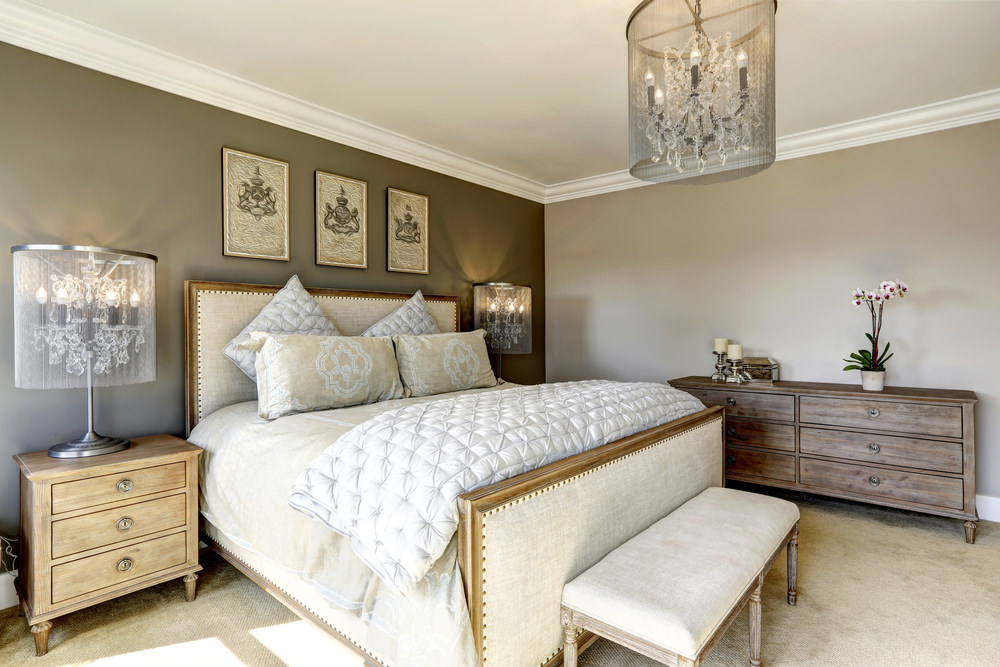
Bedside chests (aka chest of drawers) typically have two or three drawers, making them especially useful for storing things out of sight. They also have a flat surface on top for the things you use right before dropping off to sleep. They differ from your typical dresser or chest of drawers primarily in height. The top of a bedside chest should be level with, or a few inches higher than, your mattress.
2. Bedside Cabinets

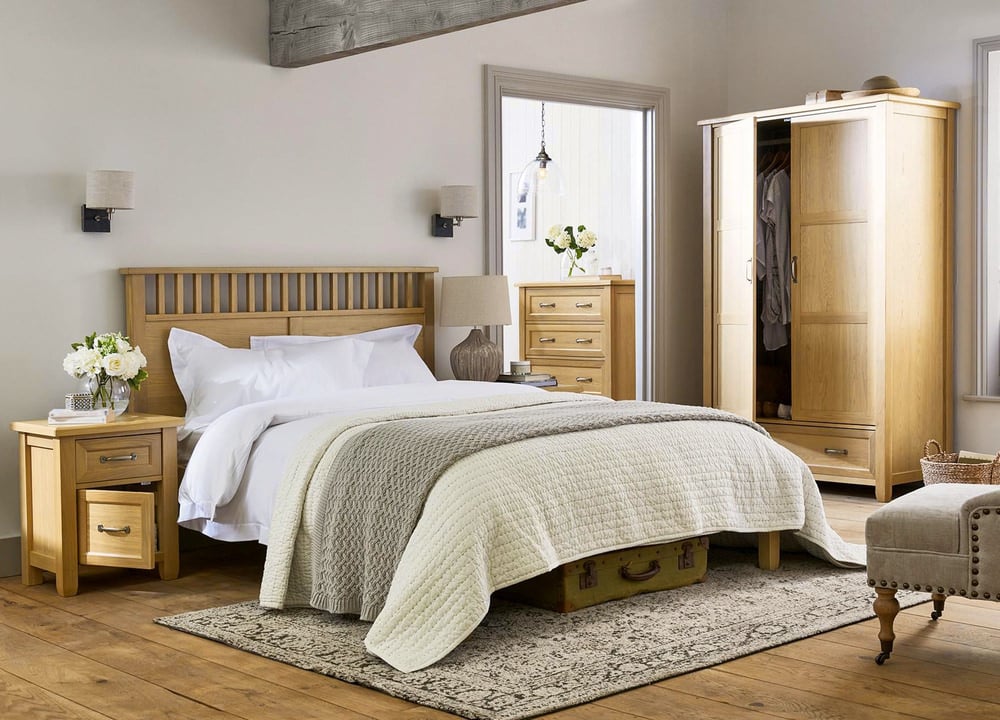
Bedside cabinets are similar to chests in that they offer plenty of storage space. They may have a drawer or two (or not) in addition to a useful flat surface at or slightly above mattress-level. What makes them unique is that they also have a handy cabinet with a door, which is useful for storing larger items.
3. Bedside Tables

Bedside tables tend to be less about storage, and more about aesthetics — with some exceptions. They may have one or two small drawers, but the focus is the tabletop and the base. It might be most accurate to say that tables are more about their surfaces than their compartments (if they have any).
4. “Smart” Nightstands
“Smart” nightstands incorporate features like outlets, wireless charging pads, USB ports and Bluetooth speakers, that make it easier to charge and use mobile electronic devices while in bed. Some also have motion-activated night lights, sleep aids like white noise machines and lights that simulate a sunrise, drawers that can be locked and unlocked via an app, and even refrigerated drawers. These high-tech nightstands come in a range of configurations, with various numbers of drawers and shelves.
Beyond these functional categories, nightstands come in a seemingly endless variety of styles, shapes, materials and, of course, colors.
B. Nightstand Styles
Though this list is by no means inclusive of all furniture styles, the following are some of the most popular design styles for nightstands today.
5. Baroque or Louis XIV
Baroque nightstands are ornate and extravagant. Think heavy, clawed feet; intricate carved and painted details; and lots and lots of gold. Though the Baroque artistic period began in Italy immediately after the Rennaissance, Baroque furniture was first produced in France. Because the French king Louis XIV was one of the first owners of this type of furniture, and some of the pieces designed for him are considered emblematic of the style, Baroque is sometimes referred to as simply “Louis XIV.”
6. Rococo or Louis XV

The Rococo period followed the Baroque era, and was marked by gentle S-shaped curves and nature-inspired motifs. As it happens, another French King Louis lent his name to furniture from this era: Louis XV. A “Louis XV style” nightstand is instantly recognizable by its legs, which are exaggeratedly curved. Louis XIV nightstands come with and without drawers or a cabinet built in.
7. Bombe Chest

Often referred to mistakenly as a “Bombay chest,” the bombe chest takes its name from the French word for bomb, as in explosive. It’s not clear whether it was named this way because its shape resembled an actual bomb or it because it bulged as though a bomb had gone off inside it. In any case, there’s nothing subtle about a bombe chest.
Often associated with both the Baroque and the Rococo styles, it’s curvy, elegant and a major statement piece. It also offers ample storage space, with its roomier-than-average drawers.
8. French provincial
French provincial nightstands may be best known for their curved legs, scalloped details, and ornate, nature-inspired hardware. They also tend to be painted in light colors. When applied to furniture, the term provincial means a style inspired by what is currently popular in the cities, but developed in more remote areas and adapted to the materials and lifestyles of those regions.
In some ways, French provincial nightstands are like airier, more rustic versions of Baroque and Rococo ones.
9. Chippendale
If you like your furniture traditional, understated and luxurious, a Chippendale style bedside chest may be for you. Modeled on the work of a London cabinetmaker named Thomas — you guessed it — Chippendale, the style became popular in America in the 1700s, during the Colonial period.
Traditionally made of dark mahogany wood, Chippendale bedside chests come in cherry and other woods as well. Though Chippendale furniture is notoriously expensive, copies are abundant and reasonably priced.
10. Shaker
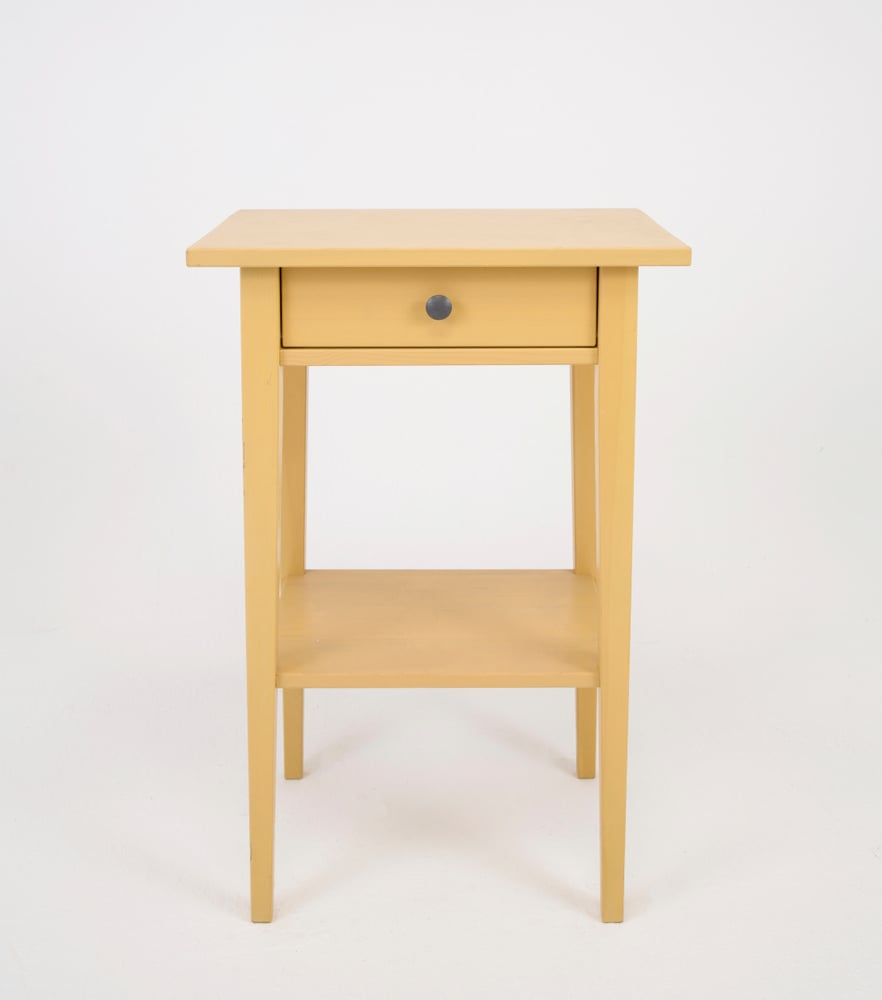
The slender Shaker nightstand, with its long legs and single drawer, may be the most recognizable example of Shaker craftsmanship. The Shakers, a Protestant religious group that originated in England and came to America in 1774, were primary furniture makers. Guided by the principles of honesty, utility and simplicity, they handcrafted chairs, tables, dressers, wardrobes and benches that were, and still are, widely recognized for their minimalist design and high quality.
Unlike the furniture makers of the Baroque period in Italy, the Shakers rejected excessive ornamentation as they believed it encouraged pride, which they considered a sin. Rather than lavishly decorating their pieces, they designed them so that they were both simple and pleasing to the eye.
A self-sufficient people, the Shakers made their furniture using pine, maple and cherry woods grown in America rather than imported mahogany or rosewood, and turned wood knobs instead of imported brass pulls.
Though there are only a few Shakers left today, some of the original wooden furniture built by the community lives on in museums like the Metropolitan Museum of Art. Because their classic designs are still so popular, “Shaker” nightstands made to look like the originals are easy to come by.
11. Modern
a. Mid-Century

It’s easy to see why mid-century modern nightstands are so popular. Clean lines, ample storage space, multiple options with respect to color, number of drawers, etc. The modern design style, a product of the modern art movement, emphasized the idea that “form and function” were equally important.
This meant a piece of furniture must be as useful as it was beautiful. And the modern definition of beauty was simple and subtle. Hallmarks of the style are earth tones, natural materials and unfussy silhouettes.
The recent re-emergence of this design style’s popularity is sometimes attributed to the hit TV show Mad Men, which was set in the 1950s and ‘60s, when the style was first popular. For seven seasons straight, viewers were exposed to a world filled with Eames chairs, Arco floor lamps, and Florence Knoll sofas — and they loved it!
The show’s connection to the style is the reason that, when a friend of mine recently posted on Facebook about how much she loved her new “Mad Men desk,” I knew just what she meant.
b. Art Deco

Source: Wayfair
Though it doesn’t get nearly the amount of attention these days that Mid-Century style does, Art Deco also falls under the Modern style heading. (Maybe someone needs to create a TV series about an angsty guy living in the 1920s and ‘30s.) The Art Deco movement began in Paris in the 1920s.
By the 1930s, the style had influenced mass-produced furniture in the U.S. Hallmarks of Art Deco style include luxe woods like ebony and mahogany, slicked with high-gloss lacquer; shiny metals; rich leather; and accents made of exotic materials like onyx, jade and ivory.
Marquetry, the use of small pieces of wood veneer to form intricate patterns on the surface of a structure, was also popular. Geometric shapes like sunbursts, chevrons and zig-zags were common.
Though none of my friends have yet posted online about a piece of Art Deco furniture they just bought, the style is rumored to be making a comeback. If you want to be a trend-setter, perhaps a nightstand with an Art Deco feel is the way to go!
c. Contemporary
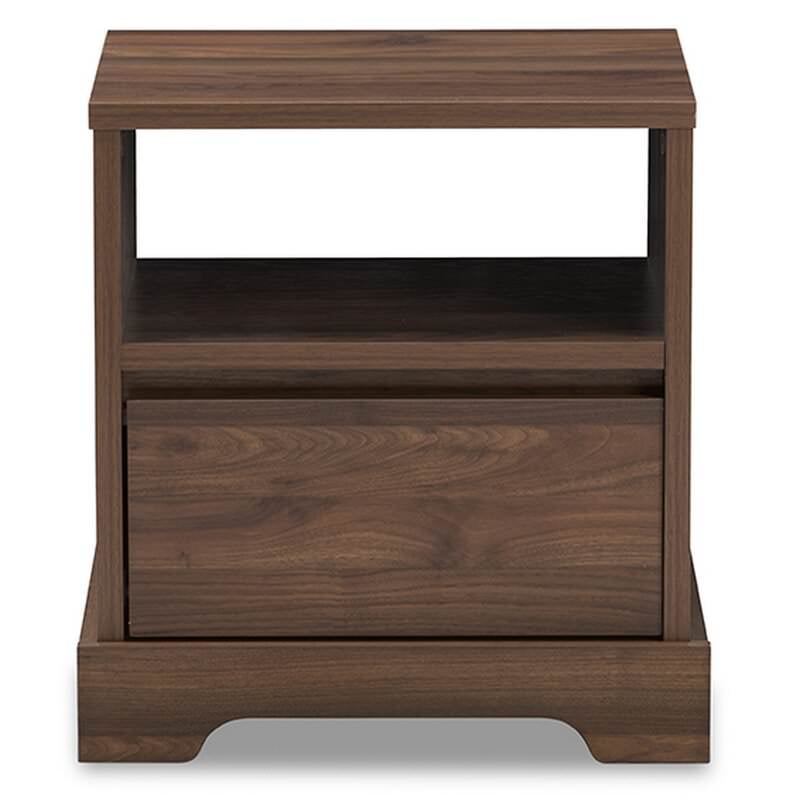
Source: Wayfair
Contemporary style is not the same as modern, but the two do have some common elements, including clean lines, an open-space feel, and a minimalist esthetic. A few ways in which contemporary differs from modern are in the materials and colors they favor. Contemporary design uses man-made materials like metal, glass and concrete, with less of an emphasis on wood.
When it comes to color, contemporary is all about bold — black, white, splashes of saturated color — while modern is more about earthy tones like brown, olive and turquoise.
Another difference between the two styles, and perhaps the most important one, is that the definition of modern is no longer changing, while the meaning of contemporary continues to evtables.inxamples of contemporary nightstands include solid-color acrylic blocks and glass tables.
12. Vintage, Retro and Antique

Source: Wayfair
The terms “vintage,” “retro” and “antique” get tossed around a lot when talking about furniture. But what do they really mean? Technically, vintage is anything considered “old,” but not more than 100 years old, while antiques are items that have been around for more than a century.
Retro is harder to define. In fact, it seems to have several meanings, including something that is made to look like it’s from a particular past era. The important thing to know about all these terms is that they mean different things to different people.
If you think you may want a vintage, retro or antique nightstand, do you your research to determine what that actually means to you. And if anyone wants to sell (or give) you their awesome vintage, retro or antique nightstand, make sure you see some pictures before you say yes!
C. By Shape
13. Pedestal
Simple, modern, and bold, a pedestal nightstand gives your bedroom that “museum” feel. If you’re looking for a wide selection of pedestal nightstands, allmodern.com is a good source.
14. Cube or Block
Made of acrylic, reclaimed wood, stone, concrete or a variety of other materials, cubes or blocks are great for when you want a nightstand with some weight to it. Cube tables can be simple and plain or come with textures and designs carved into them. They are available in every color and finish. Some cube nightstands also have hidden storage compartments.
In addition to solid, weighty cubes, there are hollow blocks that give an airier feel while maintaining a cube’s strong, straight lines and right angles. Block-type end or bedside tables are popular right now, and can be found at many retailers. Some are designed specifically for indoor use, while others are labeled as indoor/outdoor.
15. Round

Round tables or chests are a great way to introduce softness into your room’s overall look. The shape induces relaxation, making it a perfect complement to your bed. There are cylinder-shaped nightstands, as well as tables with round tops on various types of bases or legs. The cylindrical types in particular have abundant storage space. Every design type has its round pieces, so it’s to find one that fits your personal style.
D. Unique Options
Also check out unique nightstand ideas here.
16. Multi-level or Tiered
The multi-level or tiered nightstand offers you separate places to rest your different types of bedtime accoutrements. A place for your drinking glass, another for your eyeglasses, etc. Some have drawers and/or cabinets built in. These types of nightstands are found primarily in modern and contemporary collections.
17. Table with Niche
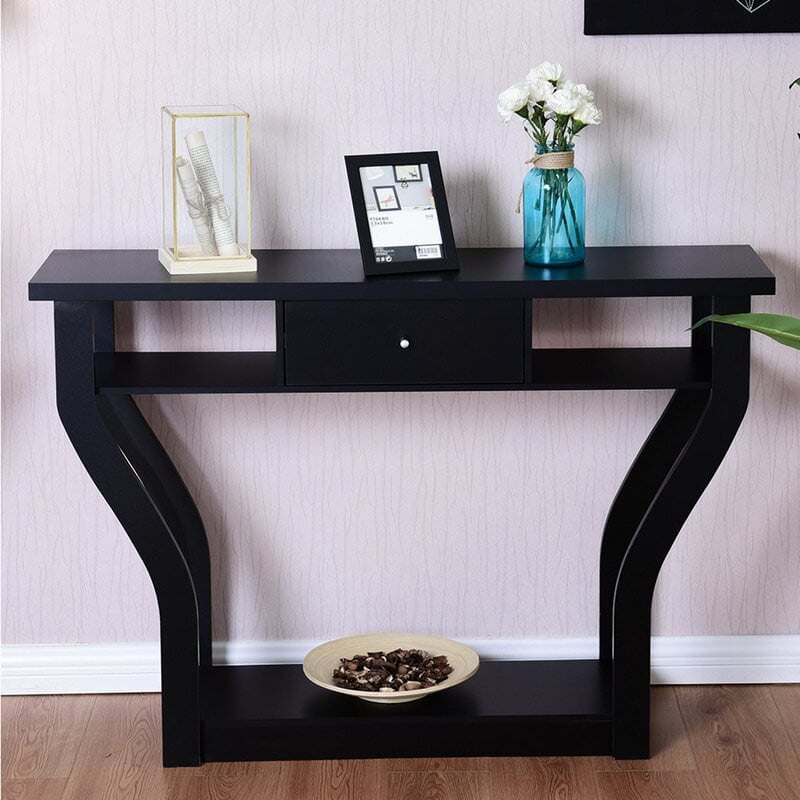
Source: Wayfair
This classic gives you a large space beneath the table and drawer to store things like a stack of books, a pair of slippers, or maybe a plant.
18. Desk (Stationary)

When placed next to your bed, a desk can double as a nightstand. This an especially terrific option when bedroom space is limited. If your desk has drawers, consider dedicating one or more to storage of things you use right before hitting the sack.
19. Desk (Rolling)
A desk with wheels that doubles as a nightstand can be a huge space saver — and a major productivity booster as well. Not the prettiest, but saves space and does the job.
20. Cocktail table
Gone are the days when a nightstand was expected to be part of a matched bedroom set that included the dresser and bed. Placing a cocktail table next to your bed is an easy way to introduce a new and unexpected element of style to your bedroom. Eclectic and elegant.
21. Floating

Floating or wall-mounted nightstands provide the benefits of bedside tables or chests without taking up floor space. They also add a cool, modern look to your room. They do take some time and effort to install, and you must be sure to get the height just right before drilling any holes.
22. Glass
A simple glass bedside table is the ultimate in clean and modern.
23. Mirrored
To instantly give your bedroom an air of luxury, try a mirrored glass bedside chest.
24. Drum table
Certain types of drums are the perfect height and have just the right surface area to double as nightstands. What’s more, many are colorfully and interestingly decorated, making them great statement pieces.
25. Functional Art
Some nightstands look more like sculptures than bedside tables. These types of nightstands don’t offer a lot of (or any) storage space, but they more than make up for it in the visual interest and personality they add to your bedroom.
26. Open Bookshelves

If you’re a reader, and especially one who likes to read in bed, check two items off your bedroom furniture list with a set of open bookshelves that stands right next to your bed. Leave one shelf free of books for your night-time accessories.
27. Built-in to the Bed

Some beds come with nightstands built into their headboards. And, answering a long-unmet need, some loft and bunk beds now come with attached “nightstands.” (They’re not fancy, but they do give you a place to put a glass of water and your cell phone.)
28. Attached to the Bed
If you just need somewhere to keep your stuff, or a flat surface to write or prop your laptop on while you recline in bed, there are numerous genius inventions that may serve your purpose, eliminating the need for an actual nightstand. There are pockets that attach to your bed via a flap that slides under the mattress, small shelves that clip on to the bed frame, and more.
29. Chair as nightstand

If short on tables but have extra chairs, solve two problems by using a chair as a nightstand. Maybe not ideal, but it does the job.
30. Ottoman nightstand
Not conventional but it does the job. If you don’t need a hard surface, there’s no reason a small ottoman can’t work as a bedside table. After all, ottomans are often used as coffee tables, so why not a bedside table. I personally like the ones with storage like the example above.
E. DIY/Upcycled Nightstand Options
According to some bloggers, you can turn practically anything into a nightstand. Here are just a few DIY nightstand ideas:
- Small filing cabinet
- Wooden boxes or crates
- Stack of vintage suitcases
- Stool, chair, or bench
- Trunk (steamer, wicker, etc.)
- Ladder
- Tree stump
- Plant stand
- Wine barrel
- Metal barrel
- Bar cart
- Metal milk can
- Upside down trash can
- Salvaged wood
- Cinder blocks
- Pieces of industrial beams
F. FAQs
Are nightstands necessary?
When it comes to home decor, there is not one piece of furniture that is strictly necessary. Several factors need to be considered when choosing home furnishings: form, function, and aesthetics.
Today’s commercially available furniture can be purchased as whole sets, such as a bedroom set, or a la carte, which provides options for people who wish to include only a select few items of furniture.
Nightstands are not only an aesthetically pleasing design element but a practical one as well. Many people appreciate the usefulness of nightstands as well as the symmetry that they can provide to well-balanced bedroom design.
What are nightstands used for?
Nightstands have a surprisingly long history. Before the advent of indoor plumbing and flush toilets, to avoid going outdoors in the middle of the night to use the outhouse, people would use chamber pots.
Nightstands were often small wooden cabinets used to store chamber pots when not in use. Depending on the wealth of the owner, nightstands could be as elaborate or utilitarian as one desired and often featured a door and shelves.
Today, nightstands come in myriad materials and styles and are used to support things like alarm clocks, bedside lamps, medical equipment, and to store items like lotions, medications, or other personal products. Like their predecessors, they may have drawers, shelves, and drawers.
Why are nightstands so short?
Nightstands are generally shorter than other types of tables, storage solutions, or end tables in order to be level with a bed frame. Though some can be quite tall, especially when part of a bedroom set that is higher than what is typically available commercially, most tend toward the shorter side. Many commercially available nightstands are made to accommodate the average mattress height of 25 inches.
How tall are typical nightstands?
Most nightstands are designed with beds in mind. The average mattress height is 25 inches, and nightstands are usually between 24 and 28 inches tall, to accommodate the combined height of the mattress, box spring, and bed frame.
How wide are typical nightstands?
Most commercially available nightstands can range anywhere from 20 to 40 inches wide. When choosing a nightstand, it is important to consider what you will be storing on top of it, as well as the space constraints of the room. More minimalist design approaches may wish to use a nightstand that is on the narrower side.
Some medical equipment, like CPAP machines, take up quite a bit of nightstand real estate, so a wider nightstand may be more practical for those who need medical equipment but also want a bedside lamp and alarm clock.
How deep are the typical nightstands?
Most nightstands — especially those that come as part of a bedroom set — are approximately 20 inches deep. However, nightstands can be shallower or deeper, depending on factors like customization and whether or not you are repurposing another item of furniture. Generally, it is best to avoid anything that is deeper than 24 inches. Anything deeper than 24 inches can make it awkward getting in and out of bed.
Can nightstands be taller than the bed?
Ideally, nightstands should be level with the mattress or only just slightly taller — no more than an inch or two — than the bed. Nightstands are designed to be practical pieces of furniture to enable ease of access to things that might be needed in the middle of the night. The higher the nightstand, the more difficult it is to reach items that you may need in the middle of the night, like a water glass or medicines, or to snooze your alarm clock.
Can you use two different nightstands in the same bedroom?
There is no hard and fast rule about what kinds of nightstands can be used in a bedroom. It all comes down to personal taste and the design aesthetic that you are trying to achieve. Bohemian design tends to use an eclectic collection of seemingly mismatched furniture while more modern design aesthetics go for clean lines, balance, and symmetry.
How close to the bed should nightstands be?
You want to place your nightstand close enough to your bed so that you can reach what you need, but not so close that you could knock items off of the top while you are sleeping. For the average-sized nightstand, two inches is about the ideal placement distance from your bed.
However, for larger nightstands or larger bedrooms, you may wish to opt for a little more space between nightstand and bed. Just remember that the point of a nightstand is to keep items that you need within reach, so you keep your nightstand no more than four inches from the bed.
Can two nightstands in the same bedroom be different heights?
While you would ideally want nightstands to be the same approximate height and level with the mattress to achieve a balanced and even look for your bedroom. However, balance is in the eye of the beholder. Rooms that have two or more beds may require different types and heights of nightstands in order to accommodate the different heights and placement of the beds.
Can nightstands be used as end tables?
Commercially available nightstands are generally made to be used in bedrooms. However, there are no specific interior design rules about where you can use a nightstand; it all comes down to what works best for your home and needs. Many beautiful and functional interior designs can be achieved by repurposing furniture for different functions — including nightstands.
What materials are nightstands made out of?
The kind of materials that your nightstand is made from will have a big impact on the overall feel of your room. Nightstands can be made out of just about any material, though they are commonly made out of wood, composite or manufactured wood. You can also find nightstands made from metal, glass, mirrors, and even stones or cement.
Can nightstands be recycled?
Depending on the material the nightstand is made from, some nightstands can be recycled. However, if the wood has been painted, pressure treated, varnished, or stained, it will not be a good candidate for recycling. Other items, like glass or mirror tops and certain types of plastic, also cannot be recycled.
If you no longer have a need for your nightstand, consider up-cycling or repurposing it. Otherwise, consider donating your unwanted nightstand. Many charities and second-hand stores will gladly accept donations of functional nightstands that are in good repair.





















